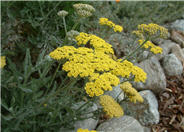
Common name:Moonshine Yarrow
Botanical name:Achillea 'Moonshine'
'Moonshine' is an upright, clump-forming, compact hybrid yarrow, with deeply-dissected, fern-like, aromatic, silvery to gray-green foliage. Flowers are long-lasting, bright lemon-yellow, and bloom throughout the summer on stiff, erect stems. This plant resembles A. 'Coronation Gold' except it is much smaller and the flowers are a lighter yellow. Grows about 18 inches tall and 24 inches wide, and seems to be slightly less invasive then other yarrow, keeping a more clumping habit. A great addition to a sunny perennial border.
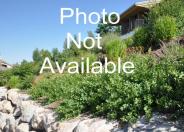
Common name:Hummingbird Trumpet; Fire Chalice
Botanical name:Zauschneria latifolia
Eye-catching as red lipstick, little red-orange trumpets stand out from leafy stems, creating a lovely sphere of color that lasts from mid-summer to frost. Native to droughty, rocky places at higher elevations, it also makes its home along waterways, indicating that a little additional water will be appreciated and used to extend the flowering season. Fire Chalice will form a slightly woody perennial base then die back to the ground with the coming of the first hard frosts. Grows 12 to 18 inches tall and about 24 to 36 inches wide.
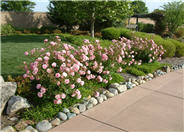
Common name:Meidiland Varieties Rose selections
Botanical name:Rosa x Meidiland Varieties
Meidiland roses are nearly ubiquitous in commercial and institutional landscapes, offering summer-long color and surprising durability for a rose. Generally growing about 1 to 2 feet tall with a spread of about 4 to 5 feet, they have a pleasant arching habit that makes them useful as a sort-of groundcover, or for cascading over walls. They do not require deadheading to remain flowering, and bloom from May to frost. Available in a variety of reds, pinks, and white. Dark green foliage and hips that ripen red in the fall, persisting into winter.
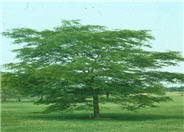
Common name:Shademaster Honeylocust
Botanical name:Gleditsia triacanthos 'Shademaster'
Shademaster Honeylocust is a deciduous tree with upright, ascending branches and a spreading habit. It has small, pinnately compounded leaves, resulting in filtered, dappled shade. Fall color is yellow; the tiny leaves readily compost in the landscape. Grows about 45 feet tall and 35 feet wide. A good shade tree for the landscape, lawn, house, or sidewalk.

Common name:Karl Foerster Feather Reed Grass
Botanical name:Calamagrostis acutiflora 'Karl Foerster'
Karl Foerster feather reed grass is a garden favorite, and for good reason. Its green, fine-textured foliage is gently arching and grows to about 2 feet tall and wide. Oat-like plumes stand very erect over the foliage, growing as tall as 5 to 6 feet. Plumes open whiteish green, later turning a dusky rose, and then tawny colored by winter. Blooms early summer with the plumes lasting into autumn. Holds its presence well into winter. Excellent in mixed perennial or shrub borders, or massed.
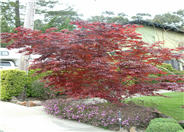
Common name:Red Cutleaf Japanese Maple
Botanical name:Acer palmatum 'Atropurpureum'
This Japanese Maple has an upright, rounded form. Leaves emerge bright red in spring, and deepen to a burgundy-bronze as they age. Fall color is brilliant red. Grows 15 to 18 feet tall and wide, though it will do so slowly.
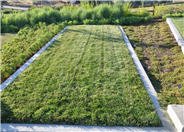
Common name:Tall Fescue
Botanical name:Festuca arundinacea
Tall fescue is a dense, clumping grass that grows well in sunny to shady areas and is often mixed with other grasses for just this quality. Tall Fescue grass was brought to the US in the early 1800’s for pasturage purposes and now grows in about 4/5 of our country, with turf type varieties used in lawns, on athletic fields, in parks and other areas where a cool season turf grass is desired. Mix with newer bluegrass varieties for a healthy, easy-maintenance, moderate water lawn.
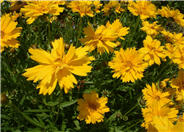
Common name:Double Sunburst Coreopsis
Botanical name:Coreopsis grandiflora 'Double Sunburst'
'Double Sunburst' Coreeopsis has showy, double to semi-double, daisy-like flowers with yellow rays and darker yellow center disks atop long, slender stems. Blooms from June to August. Leaves are lance-like, green, and mostly basal. It makes for good cut flowers, and cutting the flowers off helps to keep the plants abundant with blooms. Grows 18 to 24" tall and 12 to 18" wide.
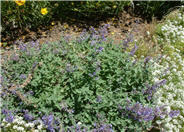
Common name:Catmint
Botanical name:Nepeta racemosa
Nepeta is a fierce little perennial, growing in poor sooils and sunny, hot conditions with never a whimper. Though different nepeta vary is size and flower color, as a general rule, all are mounded and densely leaved, with heavily crinkled, aromatic, grey-green, slightly fuzzy foliage. Flowers are like all flowers in the mint family, though on nepeta the stems tend to be shorter and the flowers closer to the foliage. Usually blue to violet, blooming late spring and sometimes again in the fall. A great addition to a sunny garden or parkstrip. Many cultivars available.
| Designer: Rick Laughlin | Grass Ranch 26 |
Photographer: GardenSoft |
Water Saving Tip:
Apply a layer of mulch around plants to reduce moisture loss.
Choose organic mulches, such as shredded bark, compost or aged sawdust.
